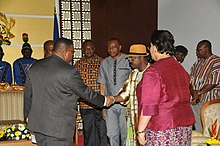
Courtesy (from the word courteis, from the 12th century) is gentle politeness and courtly manners. In the Middle Ages in Europe, the behaviour expected of the nobility was compiled in courtesy books.

Courtesy (from the word courteis, from the 12th century) is gentle politeness and courtly manners. In the Middle Ages in Europe, the behaviour expected of the nobility was compiled in courtesy books.
The apex of European courtly culture was reached in the Late Middle Ages and the Baroque period (i.e. roughly the four centuries spanning 1300–1700). The oldest courtesy books date to the 13th century, but they become an influential genre in the 16th, with the most influential of them being Il Cortegiano (1508), which not only covered basic etiquette and decorum but also provided models of sophisticated conversation and intellectual skill. [1]
The royal courts of Europe persisted well into the 18th century (and to some limited extent to the present day), but in the 18th century, the notion of courtesy was replaced by that of gallantry , referring to an ideal emphasizing the display of affected sensitivity in direct contrast with the ideals of self-denial and dignified seriousness that were the Baroque norm. During the late medieval and early modern period, the bourgeois class tended to emulate the courtly etiquette of their betters. This changed in the 19th century, after the end of the Napoleonic Wars, with the emergence of a middle class with its own set of bourgeois etiquette, which in turn was mocked in the classist theory of Marxism as petite bourgeoisie .
The analogue concept in the court culture of medieval India was known by the Sanskrit term dakṣiṇya, literally meaning "right-handedness", but as in English dexterity having a figurative meaning of "apt, clever, appropriate", glossed as "kindness and consideration expressed in a sophisticated and elegant way". [2]

Feudalism, also known as the feudal system, was a combination of legal, economic, military, cultural, and political customs that flourished in medieval Europe from the 9th to 15th centuries. Broadly defined, it was a way of structuring society around relationships derived from the holding of land in exchange for service or labour.

German literature comprises those literary texts written in the German language. This includes literature written in Germany, Austria, the German parts of Switzerland and Belgium, Liechtenstein, Luxembourg, South Tyrol in Italy and to a lesser extent works of the German diaspora. German literature of the modern period is mostly in Standard German, but there are some currents of literature influenced to a greater or lesser degree by dialects.
In historiography, periodization is the process or study of categorizing the past into discrete, quantified, and named blocks of time for the purpose of study or analysis. This is usually done to understand current and historical processes, and the causality that might have linked those events.

Etiquette is the set of norms of personal behaviour in polite society, usually occurring in the form of an ethical code of the expected and accepted social behaviours that accord with the conventions and norms observed and practised by a society, a social class, or a social group. In modern English usage, the French word étiquette dates from the year 1750.

The bourgeoisie are a class of business owners, merchants and wealthy people, in general, which emerged in the Late Middle Ages, originally as a "middle class" between peasantry and aristocracy. They are traditionally contrasted with the proletariat by their wealth, political power, and education, as well as their access to and control of cultural, social, and financial capital.

Chivalry, or the chivalric language, is an informal and varying code of conduct developed in Europe between 1170 and 1220. It is associated with the medieval Christian institution of knighthood, with knights being members of various chivalric orders, and with knights' and gentlemen's behaviours which were governed by chivalrous social codes. The ideals of chivalry were popularized in medieval literature, particularly the literary cycles known as the Matter of France, relating to the legendary companions of Charlemagne and his men-at-arms, the paladins, and the Matter of Britain, informed by Geoffrey of Monmouth's Historia Regum Britanniae, written in the 1130s, which popularized the legend of King Arthur and his knights of the Round Table.
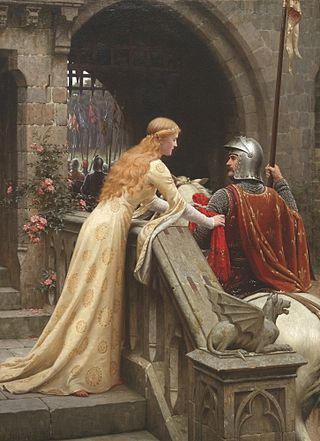
Courtly love was a medieval European literary conception of love that emphasized nobility and chivalry. Medieval literature is filled with examples of knights setting out on adventures and performing various deeds or services for ladies because of their "courtly love". This kind of love was originally a literary fiction created for the entertainment of the nobility, but as time passed, these ideas about love spread to popular culture and attracted a larger literate audience. In the high Middle Ages, a "game of love" developed around these ideas as a set of social practices. "Loving nobly" was considered to be an enriching and improving practice.

The Dark Ages is a term for the Early Middle Ages, or occasionally the entire Middle Ages, in Western Europe after the fall of the Western Roman Empire, which characterises it as marked by economic, intellectual, and cultural decline.
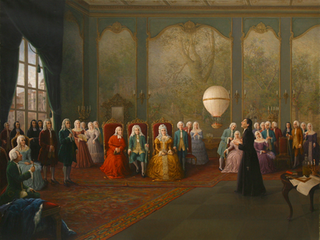
A royal court, often called simply a court when the royal context is clear, is an extended royal household in a monarchy, including all those who regularly attend on a monarch, or another central figure. Hence, the word court may also be applied to the coterie of a senior member of the nobility. Royal courts may have their seat in a designated place, several specific places, or be a mobile, itinerant court.

Medieval literature is a broad subject, encompassing essentially all written works available in Europe and beyond during the Middle Ages. The literature of this time was composed of religious writings as well as secular works. Like modern literature, it is a broad field of study, from the utterly sacred to the exuberantly profane, touching all points in between. Works of literature are often grouped by place of origin, language, and genre.

The Italian Renaissance was a period in Italian history between the 14th and 16th centuries. The period is known for the initial development of the broader Renaissance culture that spread across Western Europe and marked the transition from the Middle Ages to modernity. Proponents of a "long Renaissance" argue that it started around the year 1300 and lasted until about 1600. In some fields, a Proto-Renaissance, beginning around 1250, is typically accepted. The French word renaissance means "rebirth", and defines the period as one of cultural revival and renewed interest in classical antiquity after the centuries during what Renaissance humanists labelled as the "Dark Ages". The Italian Renaissance historian Giorgio Vasari used the term rinascita ("rebirth") in his Lives of the Most Excellent Painters, Sculptors, and Architects in 1550, but the concept became widespread only in the 19th century, after the work of scholars such as Jules Michelet and Jacob Burckhardt.

The culture of Europe is diverse, and rooted in its art, architecture, traditions, cuisines, music, folklore, embroidery, film, literature, economics, philosophy and religious customs.
A burgess was the holder of a certain status in an English or Scottish borough in the Middle Ages and the early modern period, designating someone of the burgher class. It originally meant a freeman of a borough or burgh, but later came to be used mostly for office-holders in a town or one of its representatives in the House of Commons.

Classical music generally refers to the art music of the Western world, considered to be distinct from Western folk music or popular music traditions. It is sometimes distinguished as Western classical music, as the term "classical music" can also be applied to non-Western art musics. Classical music is often characterized by formality and complexity in its musical form and harmonic organization, particularly with the use of polyphony. Since at least the ninth century it has been primarily a written tradition, spawning a sophisticated notational system, as well as accompanying literature in analytical, critical, historiographical, musicological and philosophical practices. A foundational component of Western culture, classical music is frequently seen from the perspective of individual or groups of composers, whose compositions, personalities and beliefs have fundamentally shaped its history.

The cuisine of early modern Europe was a mix of dishes inherited from medieval cuisine combined with innovations that would persist in the modern era.
Aliénor de Poitiers or Eleanor de Poitiers (1444/1446–1509) was a Burgundian courtier and writer, noted for writing Les Honneurs de la Cour, an account of precedence and ceremony at Burgundian Court, and based on her own experiences of court-life.
Conduct books or conduct literature is a genre of books that attempt to educate the reader on social norms and ideals. As a genre, they began in either the High Middle Ages or the Late Middle Ages, although antecedents such as The Maxims of Ptahhotep are among the earliest surviving works. Conduct books remained popular through the 18th century, although they gradually declined with the advent of the novel.
A courtesy book was a didactic manual of knowledge for courtiers to handle matters of etiquette, socially acceptable behaviour, and personal morals, with an especial emphasis upon life in a royal court; the genre of courtesy literature dates from the 13th century.
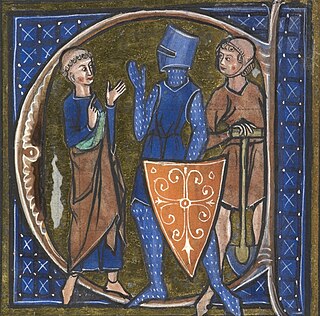
Gentry are "well-born, genteel and well-bred people" of high social class, especially in the past. Gentry, in its widest connotation, refers to people of good social position connected to landed estates, upper levels of the clergy, or "gentle" families of long descent who in some cases never obtained the official right to bear a coat of arms. The gentry largely consisted of landowners who could live entirely from rental income or at least had a country estate; some were gentleman farmers. In the United Kingdom, the term gentry refers to the landed gentry: the majority of the land-owning social class who typically had a coat of arms but did not have a peerage. The adjective "patrician" describes in comparison other analogous traditional social elite strata based in cities, such as the free cities of Italy and the free imperial cities of Germany, Switzerland, and the Hanseatic League.
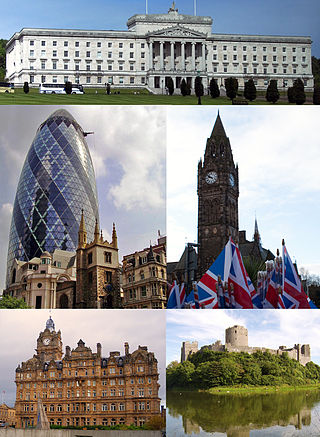
The architecture of the United Kingdom, or British architecture, consists of a combination of architectural styles, dating as far back to Roman architecture, to the present day 21st century contemporary. England has seen the most influential developments, though Ireland, Scotland, and Wales have each fostered unique styles and played leading roles in the international history of architecture. Although there are prehistoric and classical structures in the United Kingdom, British architectural history effectively begins with the first Anglo-Saxon Christian churches, built soon after Augustine of Canterbury arrived in Great Britain in 597. Norman architecture was built on a vast scale throughout Great Britain and Ireland from the 11th century onwards in the form of castles and churches to help impose Norman authority upon their dominions. English Gothic architecture, which flourished between 1180 until around 1520, was initially imported from France, but quickly developed its own unique qualities.